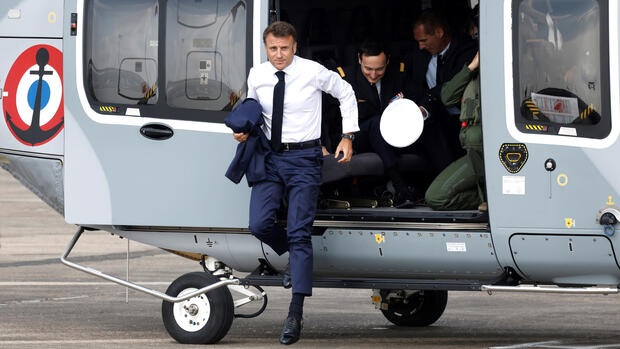Le Bourget Warplanes thunder over the small airport of Le Bourget. First, the French Rafale shows its capabilities, later the American F-35 rises. Defense ministers and other representatives from 20 European countries, who have come to an air defense summit at the invitation of French President Emmanuel Macron, will then gather in the Le Bourget conference center.
Europeans intend to invest large sums in protecting their airspace in the coming years. If Macron has his way, they should primarily develop their own weapon systems. In a speech to the ministers on Monday evening, he warned against rushing to rely on the technology from the USA.
This is a criticism of Germany. Berlin recently opted for American F-35 fighter jets and the Israeli-American “Arrow 3” missile defense system. US arms companies are hoping for more orders in Le Bourget.
F-35 manufacturer Lockheed Martin will have a large booth. Israel Aerospace Industries (IAI), which is behind “Arrow 3” together with Boeing, has rented a lot of space in one of the exhibition halls for its exhibition.
France wants strategic autonomy
The Russian attack on Ukraine has shown European countries that they urgently need to modernize their air defenses. In autumn 2022, Chancellor Olaf Scholz (SPD) proposed that the Europeans defend their airspace with a common system.
>> Read also: The European Sky Shield is taking shape
The German advance contributed significantly to the bad mood between Berlin and Paris, which led to the cancellation of the Franco-German Council of Ministers at short notice at the end of October. Although the French were invited to participate in Scholz’s “European Sky Shield Initiative” (ESSI), they did not accept the offer.
They felt taken by surprise. At the Munich Security Conference in February, Macron then announced his own conference on European air defense. In French government circles it is emphasized that the meeting in Le Bourget should not be a competition event for the German initiative. This is seen in Paris as a pure procurement alliance that does not answer important strategic questions about the future defense of airspace over Europe.
Macron indirectly accuses Germany of “mistakes”.
The Essi initiative will probably rely on the “Arrow 3” system. Macron has now said it would be a “mistake” to hastily procure non-European weapon systems without first jointly analyzing the threat scenarios. “Then we buy massively what’s on the shelves, even if it later turns out to be useless.”
He called for armaments made in Europe to be preferred. “Why do we still have to buy American products too often?” he asked and immediately gave the answer himself: the Americans had “standardized much more” and supported their manufacturers with massive subsidies.
>> Read also: Macron sees his country in the “war economy” – arms companies benefit
Observers also consider the German approach to be half-baked: “The lack of political unity shows that the German initiative does not take European security interests into account, does not convince partners and leaves many questions on the strategic, military, industrial and economic level unanswered,” says an analysis of the Foundation Science and Politics for Essi. “The overall equation to be solved is: The capability gap must be closed as quickly as possible without weakening or even endangering the European development programs.”
The initially postponed decision on German participation in the conference in Le Bourget shows how much things are still jerky between Paris and Berlin on the subject of air defense. Accordingly, the French only counted on State Secretary Benedikt Zimmer as a representative of the Federal Ministry of Defense. It was only clear a few hours before the start that Defense Minister Boris Pistorius (SPD) would be arriving himself.
Government circles in Berlin said that Pistorius wanted to make it clear at the conference that the Essi project was not in competition with NATO and the EU, but was intended to strengthen both organizations.
Germany does not want to wait for European projects
Meanwhile, Scholz campaigned again for the German initiative at a meeting with NATO Secretary General Jens Stoltenberg. “In Europe we have to invest in air defense,” said the Chancellor in Berlin on Monday. “With the European Sky Shield Initiative, we are bringing European countries together to increase protection against ballistic missiles, cruise missiles and drones.”
Germany in particular has only partially outdated and too few air defense systems. The SWP analysis states that German capabilities can currently only protect an area roughly the size of the city of Berlin. The Bundeswehr has so far lacked a protective shield for missile defense at particularly high altitudes – the task is now to be taken over by “Arrow 3”. The Bundestag approved the funds for this last week, and the costs are estimated at around four billion euros.
>> Read also: Missile protection shield should cost the Bundeswehr almost four billion euros
The Paris Ministry of Defense points out that there are European alternatives, for example the SAMP/T, which has a comparable range to the US Patriot anti-aircraft missiles. France and Italy developed the system together.
And later comes the European air combat system FCAS, in which a combat aircraft is to work together with a squadron of drones. At the exhibition in Le Bourget, FCAS is showing a simulation on a huge screen of what the networked air combat of the future should look like. It looks like a computer game. The system should not be ready for use in the real world until 2040 at the earliest.
More: Americans involve Rheinmetall in the construction of the F-35
